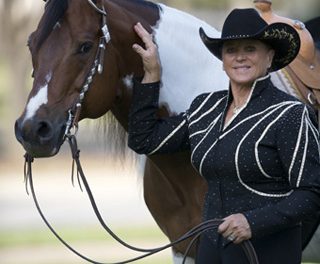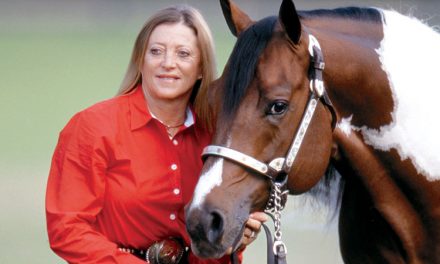Palm Partnership Training™
Building a Partnership with Your Horse
“b

The last Lynn Palm article explained how to safely and effectively work our horse at liberty. In Part I, I explained the benefits of liberty work, proper use of the whip, which is an important tool, and handler position.
So now let’s pick up from where we left off: you and a helper are positioned on the centerline of the arena that you will be working in. You have led your horse down to one end of the arena and asked him to “whoa”. You have dropped your whip on the ground and walked towards him coiling the excess longe line as you go. Now it’s time to release the longe line from his halter so he can truly be “at liberty”.
The next step is the most important because it involves the handler’s safety. To release the horse, stand off his left shoulder so he is toward you. As you unsnap the longe line from the halter, grasp the halter’s cheek piece. Ask him to “whoa” and hold him in this position for a moment. This will teach him not to get into the dangerous habit of running off the second the longe or lead is unsnapped. When you are ready, gently release your grasp and let him move away from you. This is the safest way to release him. Do not stand at his side or with his hips toward you to release him in case he would kick, buck, or swing his hips in your direction.
The first part of the lesson is to let your horse have the freedom to move and play. This lets him get the edge off and relax. This will give him a better chance for concentrating during the lesson without any pent up energy distracting him.
When first released most horses will walk or trot over to the fence or “rail”. At this point, the handler’s role is just to keep the horse moving forward, in one direction. Don’t worry about which gait he is in. Encourage him to move forward and play by clapping your hands. If needed, reinforce your request that he moves forward with the whip. If the horse tosses, nods his head, bucks, or kicks up his heels; he’s telling you that he is feeling good and is having fun. This is a good sign that he is releasing pent-up energy.
This Week…
I’ll feature a question the “Ask Lynn” section at my Palm Partnership Training website www.lynnpalm.com. This week’s question is from someone whose gelding won’t lope left circles…
Dear Ask Lynn:
My gelding will not do a cantering circle to the left to save his soul. We have long trotted to the left with no problem. He will be cantering circles to the left when longing. However he will not canter a left circle when I’m riding. He starts out the circle, but every time without fail, will fall out of it almost to the point that he hits the rail or runs into things. I keep constant outside leg pressure on him and keep light pressure on the reins the whole time. I also encourage him with my voice, but nothing. He will do circles to the right without any problem.
Dear Kristi:
To help improve your horse to stay at the lope on left circles, you first have to make sure you can recognize the left lead. The first step to learn this is from watching your horse while longing him to quickly analyze the lead from the ground. The second step is recognizing it while you are riding, under saddle, by watching both shoulders at the same time. The third step, which requires the most rider skill, is to feel the correct lead or counter lead while riding. Recognizing which lead your horse is on is essential to improve the quality and control of your horse on a circle immediately after he canters.
What I do when I am having a problem or need to improve my horse is to ask myself, what can I do better as a rider to improve my horse. If your horse canters circles to the left when lounging and doesn’t do it when you are riding him, it spells rider problems.
Have someone video you as you ride and canter your horse to the left. Review the video closely and assess your position. If you are not centered, with your position and balanced or are tilting your body inward or forward, it will encourage your horse to move out and not turn. Check the length of your reins. If they are too long, your timing will be late as you use them to turn. Or you may be too abrupt with the rein action. These types of rein action will discourage the forward motion your horse needs so he can stay on the circle at the canter.
Check your leg position. If it is too far forward or back, with the heel up, there is no way you can give your horse a clear cue to also assist in turn and stay at the lope. I suggest that you carry a crop. Put both reins in your left hand and use your crop with your right hand. Tap your gelding on barrel behind your right leg to encourage him to turn left and stay forward at the lope.
To perfect your position, I suggest that you go back to the long trot (lengthening the trot) to improve your circling to the left. Work on a larger, 60-foot diameter circle. When you feel that you have achieved a balanced position, do a transition from a lengthening trot to a left lead lope. When starting, only lope ¼- of circle then return to the lengthening trot. So this for a couple of weeks until you and your horse improve. Then build up to making the transition from the long trot to loping ½- of a circle. Finally build up to a full circle.
This may take you a month to 6-weeks to get to the full circle. Doing short segments of canter going back to the trot will teach you to: 1) control your horse during a transition, 2) control direction and speed in the gait, and 3) keep your horse responsive to your aids.
When you say your horse almost hits the rail or runs into it tells me that you are looking down while you are riding. Horses don’t do these things deliberately. You MUST keep your eyes in front of your horse head at all times.
Here’s an exercise you can use to improve the use of your eyes to guide your horse. You can also use it to practice the long trot to canter exercise I described above
Circle-Cone Exercise
Get 8 cones and set them at in pairs each ¼-point of the circle 60 feet in diameter. (If the circle were the face of a clock, you would set a pair of cones at point of the circle corresponding to 12 noon, 3:00, 6:00, and 9:00). Place each pair of cones 2-3 feet apart from each other making a little passage that you will ride through. They should be wide apart enough so you can ride between them, but close enough to challenge your steering control. Mount up and ride between the cones as you follow the circle. The cones will give you a visual cue to help follow the circle’s arc. Start at the walk and advance to the trot and finally the canter. Try doing transitions between the cones.
I hope this helps. Please let me hear from you.
Your Next Step…
Lazy, laid back horses can be real foolers when it comes to getting their energy out through liberty work. Pay special attention to give this type of horse the opportunity to play and work out pent up energy that may be “hiding” beneath his laid back demeanor. This insures he will concentrate on the lesson that you will be teaching him later and will not become difficult during some point when some hidden energy comes out.
For more information about Lynn Palm; her educational programs at Palm Equestrian Academy in Ocala, Florida; Lynn’s Ride Well clinics across the U.S.; saddles; DVDs; books; and trail and Western dressage competitions; visit www.lynnpalm.com or call 352/629-3310.



